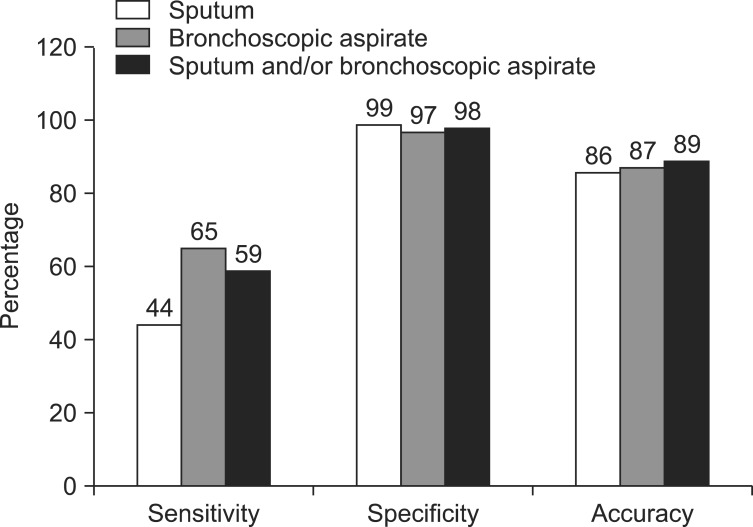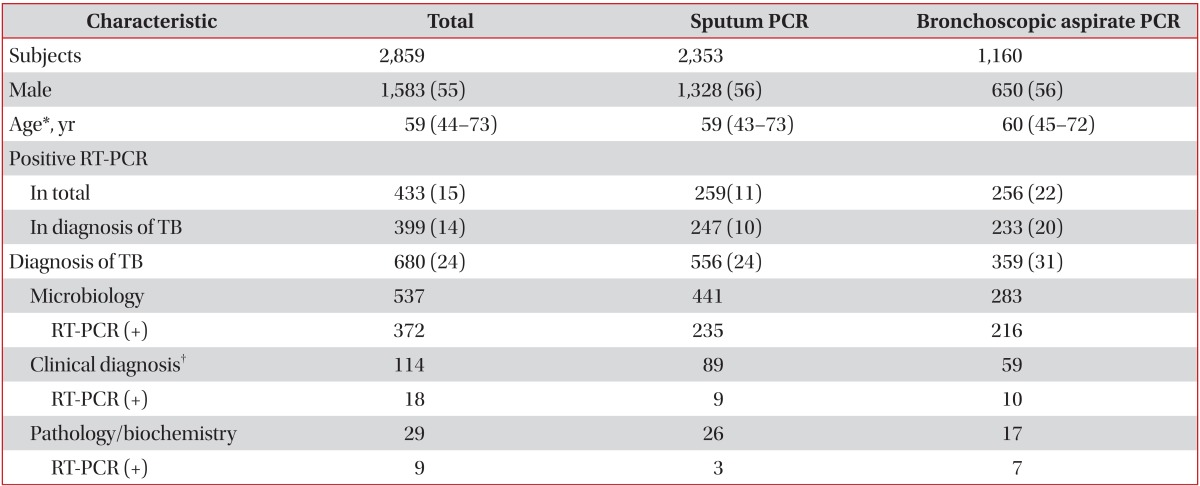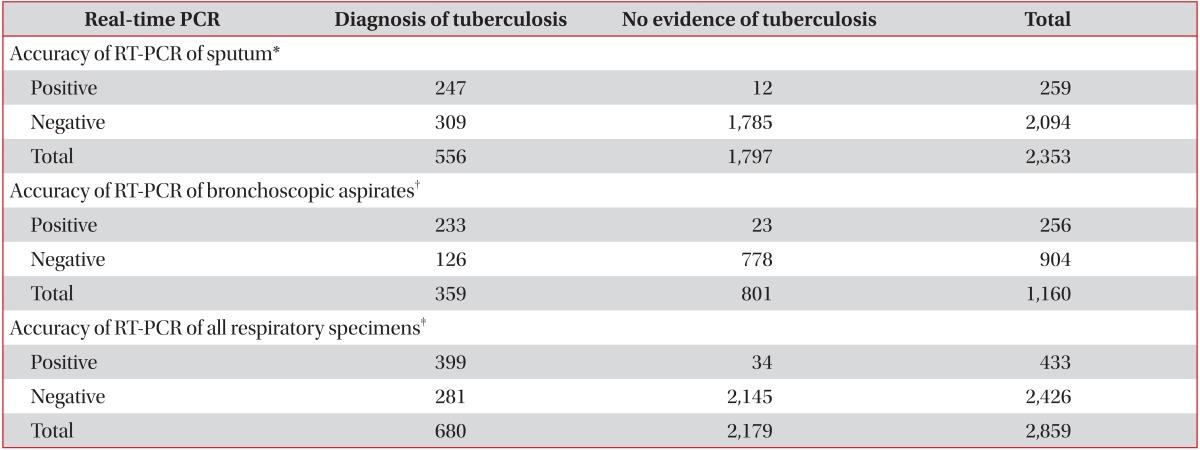2. Dye C, Watt CJ, Bleed DM, Hosseini SM, Raviglione MC. Evolution of tuberculosis control and prospects for reducing tuberculosis incidence, prevalence, and deaths globally. JAMA 2005;293:2767-2775. PMID:
15941807.


3. Levy H, Feldman C, Sacho H, van der Meulen H, Kallenbach J, Koornhof H. A reevaluation of sputum microscopy and culture in the diagnosis of pulmonary tuberculosis. Chest 1989;95:1193-1197. PMID:
2656111.


4. Ritchie SR, Harrison AC, Vaughan RH, Calder L, Morris AJ. New recommendations for duration of respiratory isolation based on time to detect Mycobacterium tuberculosis in liquid culture. Eur Respir J 2007;30:501-507. PMID:
17537768.


5. Diagnostic Standards and Classification of Tuberculosis in Adults and Children. This official statement of the American Thoracic Society and the Centers for Disease Control and Prevention was adopted by the ATS Board of Directors, July 1999. This statement was endorsed by the Council of the Infectious Disease Society of America, September 1999. Am J Respir Crit Care Med 2000;161(4 Pt 1):1376-1395. PMID:
10764337.


6. Drosten C, Panning M, Kramme S. Detection of
Mycobacterium tuberculosis by real-time PCR using pan-mycobacterial primers and a pair of fluorescence resonance energy transfer probes specific for the
M. tuberculosis complex. Clin Chem 2003;49:1659-1661. PMID:
14500592.



7. Greco S, Rulli M, Girardi E, Piersimoni C, Saltini C. Diagnostic accuracy of in-house PCR for pulmonary tuberculosis in smear-positive patients: meta-analysis and metaregression. J Clin Microbiol 2009;47:569-576. PMID:
19144797.



8. Bartlett JM, Stirling D. A short history of the polymerase chain reaction. Methods Mol Biol 2003;226:3-6. PMID:
12958470.


9. Espy MJ, Uhl JR, Sloan LM, Buckwalter SP, Jones MF, Vetter EA, et al. Real-time PCR in clinical microbiology: applications for routine laboratory testing. Clin Microbiol Rev 2006;19:165-256. PMID:
16418529.



11. Rosso F, Michelon CT, Sperhacke RD, Verza M, Olival L, Conde MB, et al. Evaluation of real-time PCR of patient pleural effusion for diagnosis of tuberculosis. BMC Res Notes 2011;4:279PMID:
21819571.



12. Min JW, Yoon HI, Park KU, Song JH, Lee CT, Lee JH. Real-time polymerase chain reaction in bronchial aspirate for rapid detection of sputum smear-negative tuberculosis. Int J Tuberc Lung Dis 2010;14:852-858. PMID:
20550768.

13. Hwang S, Oh KJ, Jang IH, Uh Y, Yoon KJ, Kim HY, et al. Evaluation of the diagnostic performance of the AdvanSure TB/NTM real-time PCR kit for detection of mycobacteria. Korean J Clin Microbiol 2011;14:55-59.

14. Master RN. Digestion-decontamination procedures, part 3.4. In: Isenberg HO, editors. Clinical microbiology procedures handbook. Vol. 1. Washington, DC: American Society for Microbiology; 1992. p. 341-344.
15. Lee H, Park KG, Lee G, Park J, Park YG, Park YJ. Assessment of the quantitative ability of AdvanSure TB/NTM real-time PCR in respiratory specimens by comparison with phenotypic methods. Ann Lab Med 2014;34:51-55. PMID:
24422196.


16. Hwang SM, Lim MS, Hong YJ, Kim TS, Park KU, Song J, et al. Simultaneous detection of
Mycobacterium tuberculosis complex and nontuberculous mycobacteria in respiratory specimens. Tuberculosis (Edinb) 2013;93:642-646. PMID:
23988279.


17. Rapid diagnostic tests for tuberculosis: what is the appropriate use? American Thoracic Society Workshop. Am J Respir Crit Care Med 1997;155:1804-1814. PMID:
9154896.


18. Cohen RA, Muzaffar S, Schwartz D, Bashir S, Luke S, McGartland LP, et al. Diagnosis of pulmonary tuberculosis using PCR assays on sputum collected within 24 hours of hospital admission. Am J Respir Crit Care Med 1998;157:156-161. PMID:
9445294.


19. Kivihya-Ndugga L, van Cleeff M, Juma E, Kimwomi J, Githui W, Oskam L, et al. Comparison of PCR with the routine procedure for diagnosis of tuberculosis in a population with high prevalences of tuberculosis and human immunodeficiency virus. J Clin Microbiol 2004;42:1012-1015. PMID:
15004046.



20. Tamura A, Shimada M, Matsui Y, Kawashima M, Suzuki J, Ariga H, et al. The value of fiberoptic bronchoscopy in culture-positive pulmonary tuberculosis patients whose pre-bronchoscopic sputum specimens were negative both for smear and PCR analyses. Intern Med 2010;49:95-102. PMID:
20075571.


21. Tueller C, Chhajed PN, Buitrago-Tellez C, Frei R, Frey M, Tamm M. Value of smear and PCR in bronchoalveolar lavage fluid in culture positive pulmonary tuberculosis. Eur Respir J 2005;26:767-772. PMID:
16264035.


22. Chen X, Yang Q, Kong H, Chen Y. Real-time PCR and Amplified MTD(R) for rapid detection of Mycobacterium tuberculosis in pulmonary specimens. Int J Tuberc Lung Dis 2012;16:235-239. PMID:
22236926.


23. Araj GF, Talhouk RS, Itani LY, Jaber W, Jamaleddine GW. Comparative performance of PCR-based assay versus microscopy and culture for the direct detection of
Mycobacterium tuberculosis in clinical respiratory specimens in Lebanon. Int J Tuberc Lung Dis 2000;4:877-881. PMID:
10985658.

24. Boehme CC, Nabeta P, Hillemann D, Nicol MP, Shenai S, Krapp F, et al. Rapid molecular detection of tuberculosis and rifampin resistance. N Engl J Med 2010;363:1005-1015. PMID:
20825313.









 PDF Links
PDF Links PubReader
PubReader Full text via DOI
Full text via DOI Print
Print Download Citation
Download Citation






